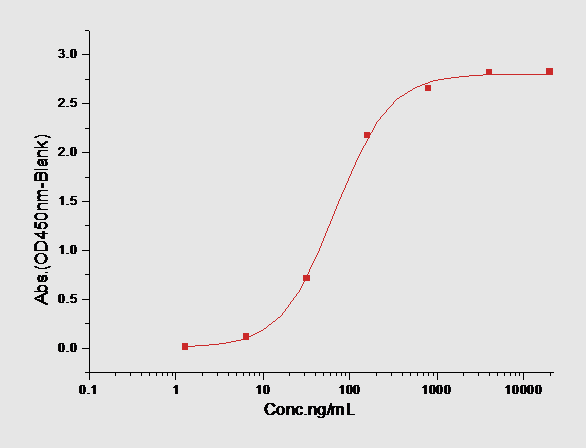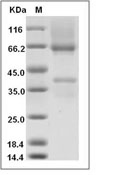Shopping Cart
- Remove All
 Your shopping cart is currently empty
Your shopping cart is currently empty

Glypican 3/GPC3 Protein, Human, Recombinant (His) is expressed in HEK293 mammalian cells with His tag. The predicted molecular weight is 62 kDa and the accession number is P51654-1.

| Pack Size | Price | Availability | Quantity |
|---|---|---|---|
| 100 μg | $286 | In Stock | |
| 200 μg | $506 | 7-10 days | |
| 500 μg | $1,070 | 7-10 days |
| Biological Activity | Measured by its binding ability in a functional ELISA. Immobilized human GPC3 at 5 μg/ml (100 μl/well) can bind human bFGF / FGF2 with a linear range of 0.156-2.5 ng/ml.  |
| Description | Glypican 3/GPC3 Protein, Human, Recombinant (His) is expressed in HEK293 mammalian cells with His tag. The predicted molecular weight is 62 kDa and the accession number is P51654-1. |
| Species | Human |
| Expression System | HEK293 Cells |
| Tag | C-His |
| Accession Number | P51654-1 |
| Synonyms | SGBS1,SGBS,SGB,SDYS,OCI-5,MXR7,GTR2-2,Glypican 3,DGSX |
| Construction | A DNA sequence encoding the human GPC3 (P51654-1) (Met1-His559) was expressed with a C-terminal polyhistidine tag. Predicted N terminal: Gln 25 & Ser 359 |
| Protein Purity | > 87 % as determined by SDS-PAGE  |
| Molecular Weight | 62 kDa (predicted) |
| Endotoxin | < 1.0 EU/μg of the protein as determined by the LAL method. |
| Formulation | Lyophilized from a solution filtered through a 0.22 μm filter, containing PBS, pH 7.4. Typically, a mixture containing 5% to 8% trehalose, mannitol, and 0.01% Tween 80 is incorporated as a protective agent before lyophilization. |
| Reconstitution | A Certificate of Analysis (CoA) containing reconstitution instructions is included with the products. Please refer to the CoA for detailed information. |
| Stability & Storage | It is recommended to store recombinant proteins at -20°C to -80°C for future use. Lyophilized powders can be stably stored for over 12 months, while liquid products can be stored for 6-12 months at -80°C. For reconstituted protein solutions, the solution can be stored at -20°C to -80°C for at least 3 months. Please avoid multiple freeze-thaw cycles and store products in aliquots. |
| Shipping | In general, Lyophilized powders are shipping with blue ice. |
| Research Background | Glypican-3, also known as Intestinal protein OCI-5, GPC3, and OCI5, is a member of the glypican family. It belongs to the glypican family and is highly expressed in the lung, liver, and kidney. It is a heparan sulfate proteoglycan, which is overexpressed in various neoplasms such as hepatocellular carcinoma, malignant melanoma, and testicular yolk sac tumor, and plays an important role in cell growth and differentiation. GPC3 function is tissue-dependent. In some tissues, GPC3 acts as a tumor suppressor gene, whereas in others, it acts as an oncofetal protein. Studies have shown that GPC3 is a reliable marker for hepatocellular carcinoma. The sensitivity and specificity exceed both alpha-fetoprotein and hepatocyte-paraffin1. GPC3 immunohistochemistry can aid in the differentiation of testicular germ cell tumors, being expressed in all yolk sac tumors but not in seminomas. GPC3 expression has also been identified in some squamous cell carcinomas of the lung and clear cell carcinomas of the ovary. The role of GPC3 in melanomas is still controversial. Thus, Glypican-3 is currently regarded as a tumor marker and potential target for immunotherapy.Cancer ImmunotherapyImmune CheckpointImmunotherapyTargeted Therapy |

Copyright © 2015-2025 TargetMol Chemicals Inc. All Rights Reserved.